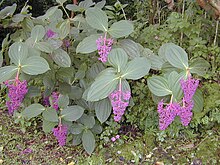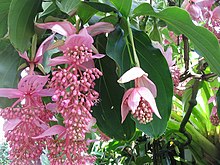Medinilla is a genus of about 368 species of flowering plants in the family Melastomataceae, native to tropical regions of the Old World from Africa east through southeast Asia to Australia and the western Pacific Ocean. The genus was named after José de Medinilla y Pineda, governor of the Mariana Islands in 1820.[1]
| Medinilla | |
|---|---|

| |
| Medinilla cumingii | |
| Scientific classification | |
| Kingdom: | Plantae |
| Clade: | Tracheophytes |
| Clade: | Angiosperms |
| Clade: | Eudicots |
| Clade: | Rosids |
| Order: | Myrtales |
| Family: | Melastomataceae |
| Genus: | Medinilla Gaudich. ex DC.[1] |
| Species | |
|
Many, see list of species | |
| Synonyms[1] | |
| |

Species in this genus are evergreen shrubs or vines. The leaves are opposite or whorled, or alternate in some species. The flowers are white, pink, red, or orange, and are produced singly or in large panicles.[citation needed]
Selected species
editFor a complete list of species, see List of Medinilla species
The following species have articles on Wikipedia:
- Medinilla balls-headleyi F.Muell. – Queensland
- Medinilla beamanii Regalado – Borneo
- Medinilla cummingii Naudin – Philippines
- Medinilla magnifica Lindl. – Philippines
- Medinilla multiflora Merr. – Philippines
- Medinilla sedifolia Jum. & H.Perrier – Madagascar
- Medinilla speciosa Blume – Philippines
- Medinilla theresae Fernando – Philippines
- Medinilla waterhousei Seem. – Fiji
References
edit- ^ a b c "Medinilla Gaudich. ex DC". Plants of the World Online. Royal Botanic Gardens, Kew. 2024. Retrieved 19 October 2024.
External links
editWikimedia Commons has media related to Medinilla.
- Renner, S. S. (2004). Multiple Miocene Melastomataceae dispersal between Madagascar, Africa and India. Philos. Trans. R. Soc. Lond. B Biol. Sci. 359(1450): 1485-1494 (pdf file)